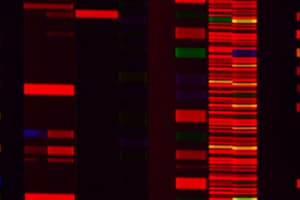Podcast
Questions and Answers
What is the primary purpose of using electrophoresis?
What is the primary purpose of using electrophoresis?
- To assess the purity of DNA, RNA, and proteins
- To characterize the structure and function of proteins
- To separate and isolate peptides, DNA, and RNA
- All of the above (correct)
Which type of electrophoresis is best suited for the separation of small molecules?
Which type of electrophoresis is best suited for the separation of small molecules?
- Agarose gel electrophoresis
- SDS-PAGE
- Capillary electrophoresis (correct)
- Western blotting
What is the primary factor that determines the speed of migration (mobility) of molecules during electrophoresis?
What is the primary factor that determines the speed of migration (mobility) of molecules during electrophoresis?
- The ionic strength of the medium
- The size of the molecules
- The charge of the molecules (correct)
- The voltage applied
Which type of electrophoresis is commonly used for the separation and analysis of proteins?
Which type of electrophoresis is commonly used for the separation and analysis of proteins?
Which of the following is NOT a common application of electrophoresis?
Which of the following is NOT a common application of electrophoresis?
What is the main advantage of capillary electrophoresis over other types of electrophoresis?
What is the main advantage of capillary electrophoresis over other types of electrophoresis?
What is the purpose of loading dye in agarose gel electrophoresis?
What is the purpose of loading dye in agarose gel electrophoresis?
In SDS-PAGE, what is the function of SDS (sodium dodecyl sulfate)?
In SDS-PAGE, what is the function of SDS (sodium dodecyl sulfate)?
Which type of gel electrophoresis is based on iso-electric points (pI)?
Which type of gel electrophoresis is based on iso-electric points (pI)?
What is the purpose of immunoblotting (Western blotting) in protein analysis?
What is the purpose of immunoblotting (Western blotting) in protein analysis?
Which method would be most suitable for separating DNA fragments based on size?
Which method would be most suitable for separating DNA fragments based on size?
What is the purpose of stacking gel in SDS-PAGE?
What is the purpose of stacking gel in SDS-PAGE?
Polyacrylamide gel electrophoresis has a larger pore size compared to agarose gel electrophoresis.
Polyacrylamide gel electrophoresis has a larger pore size compared to agarose gel electrophoresis.
Capillary electrophoresis uses a wide capillary with buffer for separation.
Capillary electrophoresis uses a wide capillary with buffer for separation.
In electrophoresis, smaller and less charged molecules move faster than larger and more charged molecules.
In electrophoresis, smaller and less charged molecules move faster than larger and more charged molecules.
The primary application of DNA sequencing is clinical diagnosis.
The primary application of DNA sequencing is clinical diagnosis.
Agarose gel electrophoresis is commonly used for protein analysis.
Agarose gel electrophoresis is commonly used for protein analysis.
Western blotting is a type of capillary electrophoresis technique.
Western blotting is a type of capillary electrophoresis technique.
Agarose gel electrophoresis is only suitable for the separation of proteins and not DNA or RNA.
Agarose gel electrophoresis is only suitable for the separation of proteins and not DNA or RNA.
The resolving gel in a discontinuous SDS-PAGE system has a higher pH than the stacking gel.
The resolving gel in a discontinuous SDS-PAGE system has a higher pH than the stacking gel.
The molecular weight of a protein can be determined using $e^{-0.3M_r}$ as the relationship between electrophoretic mobility and molecular weight in SDS-PAGE.
The molecular weight of a protein can be determined using $e^{-0.3M_r}$ as the relationship between electrophoretic mobility and molecular weight in SDS-PAGE.
Isoelectric focusing gels are used to separate proteins based on their isoelectric point (pI), while 2D PAGE gels are used to separate proteins based on both their molecular weight and charge.
Isoelectric focusing gels are used to separate proteins based on their isoelectric point (pI), while 2D PAGE gels are used to separate proteins based on both their molecular weight and charge.
Capillary electrophoresis is less sensitive than traditional gel-based electrophoresis for the separation and analysis of DNA samples.
Capillary electrophoresis is less sensitive than traditional gel-based electrophoresis for the separation and analysis of DNA samples.
The main function of SDS (sodium dodecyl sulfate) in SDS-PAGE is to denature proteins and impart a uniform negative charge, allowing for separation based solely on molecular weight.
The main function of SDS (sodium dodecyl sulfate) in SDS-PAGE is to denature proteins and impart a uniform negative charge, allowing for separation based solely on molecular weight.
Flashcards are hidden until you start studying
Study Notes
- Electrophoresis is a technique that uses an electrical field to separate molecules based on their size, charge, and mobility in different types of gels such as agarose, polyacrylamide, and capillary.
- Different types of electrophoresis include agarose gel electrophoresis for DNA, SDS-PAGE for proteins, and capillary electrophoresis for high-resolution and fast separation.
- Applications of electrophoresis include DNA fingerprinting, DNA sequencing, protein analysis, clinical diagnosis, and pharmaceutical development for characterizing biologics like antibodies and vaccines.
- Agarose gel electrophoresis is used for DNA and RNA analysis, with pore sizes ranging from 0.5%-2%, and it involves loading dye, staining with Ethidium bromide, and size determination.
- SDS-PAGE is a method for protein analysis using a polyacrylamide gel with SDS to denature proteins, a discontinuous buffer system, and staining with Coomassie blue for size determination.
- Other types of gels used in electrophoresis include non-denaturing/native gels for protein identification, gradient gels for complex mixtures, and isoelectric focusing gels based on iso-electric points.
- Techniques like immunoblotting (Western blotting) involve transferring products to a membrane for further investigation with antibodies, while capillary electrophoresis is used for DNA sequencing and separating metabolites.
Studying That Suits You
Use AI to generate personalized quizzes and flashcards to suit your learning preferences.




